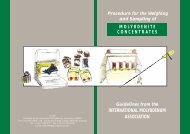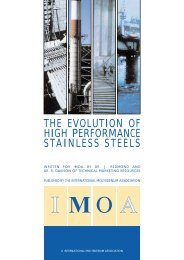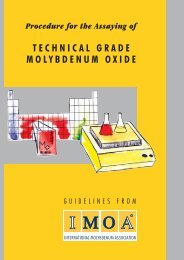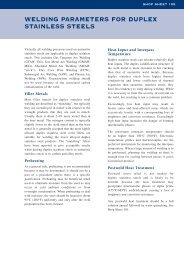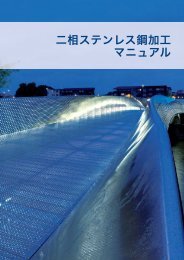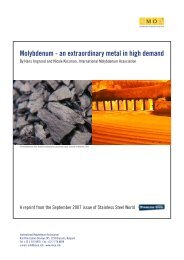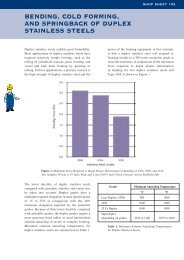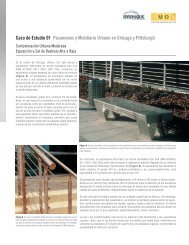Moly does the Job: Condenser in power plant - IMOA
Moly does the Job: Condenser in power plant - IMOA
Moly does the Job: Condenser in power plant - IMOA
You also want an ePaper? Increase the reach of your titles
YUMPU automatically turns print PDFs into web optimized ePapers that Google loves.
<strong>Moly</strong> <strong>does</strong> <strong>the</strong> <strong>Job</strong><br />
This article is <strong>the</strong> latest <strong>in</strong> a series of case histories where <strong>the</strong> application<br />
of moly has helped companies to solve technical problems which have<br />
occurred. Nicole K<strong>in</strong>sman of Technical Market<strong>in</strong>g Resources (Consultants<br />
to <strong>IMOA</strong>) is <strong>the</strong> author and she will cont<strong>in</strong>ue to write similar articles for<br />
future issues of this Newsletter.<br />
Edward Blessman of Trent Tube, East Troy, Wiscons<strong>in</strong>, contributed <strong>the</strong> <strong>in</strong>formation <strong>in</strong><br />
this article and <strong>IMOA</strong> would like to thank him for his assistance.<br />
Summary<br />
Many ag<strong>in</strong>g US <strong>power</strong> <strong>plant</strong>s have copper alloy<br />
condensers that are suffer<strong>in</strong>g from erosion or<br />
corrosion. Leak<strong>in</strong>g tubes have to be plugged.<br />
This requires <strong>plant</strong> shut down and leads to<br />
reduced heat transfer and lower efficiency.<br />
Many <strong>power</strong> <strong>plant</strong>s have solved <strong>the</strong> problem<br />
permanently by replac<strong>in</strong>g <strong>the</strong> tube bundles with<br />
4 to 6% molybdenum- conta<strong>in</strong><strong>in</strong>g sta<strong>in</strong>less steels.<br />
The better <strong>the</strong>rmal performance of sta<strong>in</strong>less steel<br />
re-tubed units, and <strong>the</strong> lack of unscheduled<br />
outages due to leak<strong>in</strong>g condenser tubes, more<br />
than compensate for <strong>the</strong> <strong>in</strong>itial design and<br />
<strong>in</strong>stallation cost of <strong>the</strong> new tub<strong>in</strong>g.<br />
The Process<br />
A critical part of any <strong>power</strong> <strong>plant</strong> is its condenser.<br />
It cools <strong>the</strong> steam from <strong>the</strong> turb<strong>in</strong>e and condenses<br />
it to water that is recycled back to <strong>the</strong> boiler.<br />
The amount of <strong>power</strong> that is generated is<br />
correlated to <strong>the</strong> temperature difference between<br />
<strong>the</strong> steam temperatures at <strong>the</strong> <strong>in</strong>let and outlet of<br />
<strong>the</strong> turb<strong>in</strong>e. To m<strong>in</strong>imize <strong>the</strong> condensate<br />
temperature, <strong>the</strong> condenser must maximize <strong>the</strong><br />
heat transfer between <strong>the</strong> cool<strong>in</strong>g water and <strong>the</strong><br />
steam. Good <strong>the</strong>rmal conductivity and large<br />
surface area of <strong>the</strong> tub<strong>in</strong>g are <strong>the</strong> most important<br />
parameters for optimal heat transfer.<br />
The Corrosion<br />
Copper alloys have excellent <strong>the</strong>rmal conductivity<br />
and, <strong>the</strong>refore, have been used traditionally as<br />
condenser tub<strong>in</strong>g material. However, brass and<br />
copper-nickel alloys are susceptible to erosion,<br />
sulfur pitt<strong>in</strong>g corrosion, and both ammonia<br />
groov<strong>in</strong>g and crack<strong>in</strong>g from <strong>the</strong> steam side.<br />
A leak <strong>in</strong> a condenser tube can lead to <strong>the</strong><br />
contam<strong>in</strong>ation of <strong>the</strong> high purity boiler water.<br />
This contam<strong>in</strong>ated water can damage <strong>the</strong> boiler<br />
and <strong>the</strong> turb<strong>in</strong>es. For this reason a leak<strong>in</strong>g<br />
condenser tube has to be plugged quickly and this<br />
may require an unscheduled shut down of <strong>the</strong><br />
<strong>plant</strong>.<br />
Ano<strong>the</strong>r limitation of copper alloys is <strong>the</strong> copper<br />
contam<strong>in</strong>ation of <strong>the</strong> effluent water and <strong>the</strong><br />
condensate. Environmental regulations strictly<br />
limit <strong>the</strong> release of copper <strong>in</strong>to lakes and rivers.<br />
Often <strong>the</strong> only way to comply with <strong>the</strong>se<br />
regulations is to elim<strong>in</strong>ate all copper-conta<strong>in</strong><strong>in</strong>g<br />
(Cont<strong>in</strong>ued overleaf)<br />
INTERNATIONAL MOLYBDENUM ASSOCIATION<br />
2 Baron’s Gate, 33 Rothschild Road, London W4 5HT, UK<br />
Tel: +44 20 8742 2274 Fax: + 44 20 8742 7345<br />
email: ITIA_<strong>IMOA</strong>@compuserve.com web: www.imoa.org.uk
<strong>Moly</strong> <strong>does</strong> <strong>the</strong> job<br />
alloys from <strong>the</strong> heat exchanger tub<strong>in</strong>g. Copper<br />
<strong>in</strong> <strong>the</strong> condensate can also deposit <strong>in</strong> <strong>the</strong> boiler<br />
or <strong>the</strong> turb<strong>in</strong>e and cause damage to <strong>the</strong><br />
equipment.<br />
The Solution<br />
Sta<strong>in</strong>less steel condenser tub<strong>in</strong>g solves all of<br />
<strong>the</strong>se problems. There have been more than<br />
35 million meters (almost 115 million feet) of<br />
sta<strong>in</strong>less steel (all grades) condenser tub<strong>in</strong>g<br />
<strong>in</strong>stalled <strong>in</strong> <strong>the</strong> US <strong>in</strong> <strong>the</strong> last five years (an<br />
average condenser may use 100,000 meters, a<br />
large nuclear <strong>power</strong> <strong>plant</strong> condenser can use up<br />
to 1 million meters). Over 3.5 million meters<br />
(11.5 million feet) were high performance 4 to<br />
6% molybdenum sta<strong>in</strong>less steels. Traditionally<br />
<strong>the</strong> 6% Mo high performance austenitic grades<br />
were <strong>the</strong> most common, but <strong>in</strong> recent years an<br />
<strong>in</strong>creas<strong>in</strong>g number of <strong>plant</strong>s have specified <strong>the</strong><br />
4% Mo super ferritic grades because of cost<br />
advantages. Six major <strong>plant</strong>s have re-tubed<br />
with high performance ferritics <strong>in</strong> <strong>the</strong> last two<br />
years, and many more are <strong>in</strong> <strong>the</strong> plann<strong>in</strong>g<br />
stages for <strong>the</strong> next few years.<br />
The ferritic sta<strong>in</strong>less steels are especially well<br />
suited for re-tub<strong>in</strong>g of copper alloy condensers<br />
due to <strong>the</strong>ir unique comb<strong>in</strong>ation of properties.<br />
Copper tub<strong>in</strong>g typically has a heavy wall<br />
Figure 1:<br />
Close-up of <strong>the</strong> tube<br />
sheet dur<strong>in</strong>g <strong>in</strong>stallation<br />
of replacement tub<strong>in</strong>g.<br />
thickness [0.049 <strong>in</strong>ch (1.25 mm)] to<br />
compensate for its relatively low strength, low<br />
modulus of elasticity and its susceptibility to<br />
erosion. The better mechanical properties of<br />
high performance ferritic sta<strong>in</strong>less steels allow<br />
<strong>the</strong> use of <strong>the</strong> same condenser designs with<br />
walls as th<strong>in</strong> as 0.028 <strong>in</strong>ches (0.7 mm). The<br />
good heat transfer of <strong>the</strong> ferritics ensures that<br />
<strong>the</strong> <strong>the</strong>rmal performance of <strong>the</strong> condenser<br />
rema<strong>in</strong>s high. Long-term <strong>the</strong>rmal performance<br />
is enhanced compared to copper alloys, because<br />
<strong>the</strong> very smooth surface of sta<strong>in</strong>less steel<br />
tub<strong>in</strong>g m<strong>in</strong>imizes foul<strong>in</strong>g and rema<strong>in</strong>s cleaner.<br />
The high performance sta<strong>in</strong>less steels are also<br />
resistant to erosion. When <strong>plant</strong> design will<br />
permit, it is advantageous to <strong>in</strong>crease <strong>the</strong><br />
cool<strong>in</strong>g water flow velocity. The higher velocity<br />
<strong>in</strong>creases heat transfer and improves <strong>the</strong><br />
clean l<strong>in</strong>ess of <strong>the</strong> condenser.Higher flow rates<br />
are among <strong>the</strong> most economical methods to<br />
improve condenser performance.<br />
Sta<strong>in</strong>less steels easily tolerate velocities of<br />
5 m/sec (16.4 feet/sec) without erosion.<br />
Most of <strong>the</strong> units re-tubed with high<br />
performance ferritics and austenitics are cooled<br />
by brackish or sea-water. These grades were<br />
chosen because of <strong>the</strong>ir high chloride resistance.<br />
There are also many fresh water-cooled units<br />
that could be re-tubed with standard austenitic<br />
sta<strong>in</strong>less steels such as Type 304 or 316.<br />
However, <strong>the</strong>ir <strong>plant</strong> owners selected high<br />
performance ferritics <strong>in</strong>stead. This "over-design"<br />
ensures reliability <strong>in</strong> case of upset conditions or<br />
future changes <strong>in</strong> <strong>the</strong> water chemistry, and helps<br />
to <strong>in</strong>sure aga<strong>in</strong>st forced outages because of<br />
condenser leaks.<br />
The Cost Sav<strong>in</strong>gs<br />
The reasons driv<strong>in</strong>g <strong>power</strong> <strong>plant</strong>s to upgrade<br />
condensers are improved reliability<br />
and profitability, and compliance with<br />
environmental regulations.<br />
The trend toward high Mo sta<strong>in</strong>less steels has<br />
accelerated with <strong>the</strong> transition toward an open<br />
electricity market <strong>in</strong> <strong>the</strong> US. Power <strong>plant</strong>s now<br />
compete for bus<strong>in</strong>ess, and if <strong>the</strong>ir costs are low<br />
enough, <strong>the</strong>y can sell all of <strong>the</strong> <strong>power</strong> that <strong>the</strong>y<br />
can generate.<br />
The most efficient <strong>power</strong> <strong>plant</strong>s can generate<br />
<strong>power</strong> for less than $20 per MWhr. On <strong>the</strong> spot<br />
market, at times of peak demand, for example<br />
on a hot summer afternoon when air<br />
conditioners are runn<strong>in</strong>g, <strong>power</strong> prices can be<br />
over $500 per MWhr. If a <strong>plant</strong> is off–l<strong>in</strong>e<br />
dur<strong>in</strong>g a time of peak demand, it loses <strong>the</strong><br />
opportunity to sell surplus <strong>power</strong> and it is forced<br />
to buy replacement <strong>power</strong>. For example, if a<br />
300 MW <strong>plant</strong> shuts down for 10 hours to plug<br />
leak<strong>in</strong>g tubes, it loses 3,000 MWhr of<br />
generation capacity. This <strong>power</strong> costs as little<br />
as $60,000 to generate, but, it may cost as<br />
much as $1,500,000 to purchase <strong>the</strong><br />
replacement <strong>power</strong> from ano<strong>the</strong>r <strong>plant</strong>.<br />
Many older <strong>plant</strong>s have a significant number of<br />
plugged condenser tubes. The leaks often stem<br />
from old ‘accidents’ and upsets. This reduction<br />
<strong>in</strong> heat transfer surface area may have a small<br />
effect on <strong>plant</strong> profitability dur<strong>in</strong>g a time of low<br />
demand. However, any loss of heat transfer will<br />
hurt generat<strong>in</strong>g capacity most dur<strong>in</strong>g hot<br />
wea<strong>the</strong>r, when <strong>the</strong> cool<strong>in</strong>g water is warmer and<br />
<strong>does</strong> not have <strong>the</strong> same cool<strong>in</strong>g capacity.<br />
Unfortunately, this is exactly when demand for<br />
<strong>power</strong> and its price are <strong>the</strong> highest.
Table 1:<br />
Typical Composition of High Performance Sta<strong>in</strong>less Steels <strong>in</strong> Weight Percent<br />
UNS No. Cr Mo Ni<br />
Ferritics SEA-CURE ® S44660 27 4 2<br />
AL 29-4C ® S44735 29 4 0<br />
FS 10 ® S44800 29 4 2<br />
Austenitics AL-6XN ® N08367 21 6.5 24<br />
254 SMO ® S31254 20 6 18<br />
Table 2:<br />
Typical Properties of High Performance Sta<strong>in</strong>less Steels<br />
UNS Thermal Modulus Yield Strength<br />
Conductivity [10 6 psi (GPa)] [ ksi (MPa) ]<br />
[Btu/ft hr °F<br />
(W/M °C)]<br />
Ferritics SEA-CURE ® S44660 9.5 (15.9) 31 (213) 75 (517)<br />
AL 29-4C ® S44735 9.5 (15.9) 31 (213) 80 (552)<br />
FS 10 ® S44800 9.5 (15.9) 31 (213) 85 (586)<br />
Austenitics AL-6XN ® N08367 7.5 (13) 28 (193) 55 (379)<br />
254 SMO ® S31254 7.9 (13.7) 29 (200) 50 (345)<br />
The 4% Mo ferritic and <strong>the</strong> 6% Mo austenitic high<br />
performance sta<strong>in</strong>less steels are play<strong>in</strong>g a<br />
significant role <strong>in</strong> improv<strong>in</strong>g <strong>the</strong> availability,<br />
reliability, capacity and economics of <strong>power</strong> <strong>plant</strong>s<br />
<strong>in</strong> <strong>the</strong> US.<br />
Protected trademarks:<br />
SEA-CURE:<br />
Crucible Materials Corp.<br />
AL 29-4C and AL-6XN ATI Properties,Inc.<br />
FS-10:<br />
Sumitomo<br />
254 SMO: AvestaPolarit<br />
Readers with similar experiences,<br />
where moly has assisted <strong>in</strong> solv<strong>in</strong>g<br />
problems, are <strong>in</strong>vited to contact <strong>the</strong><br />
Secretariat.<br />
Congratulations to our Consultants, Technical Market<strong>in</strong>g<br />
Resources of Pittsburgh! The firm has been hired by <strong>the</strong> Johnson<br />
Space Centre to assist <strong>in</strong> <strong>the</strong> selection of materials (sta<strong>in</strong>less<br />
steel) and surface f<strong>in</strong>ish for <strong>the</strong> tools and enclosures to hold <strong>the</strong><br />
Mars rock and soil samples which will be brought to Earth as<br />
part of <strong>the</strong> Mars Surveyor 2005 project.



